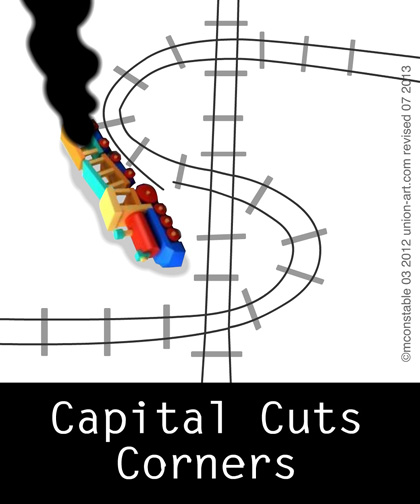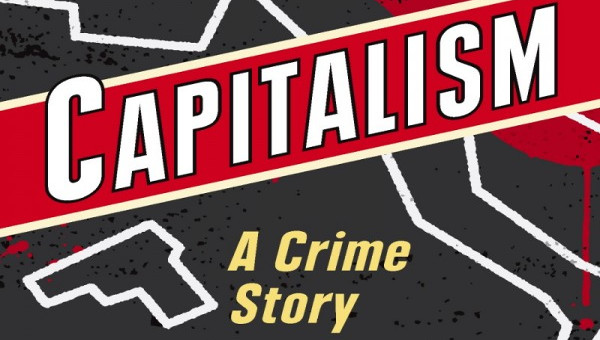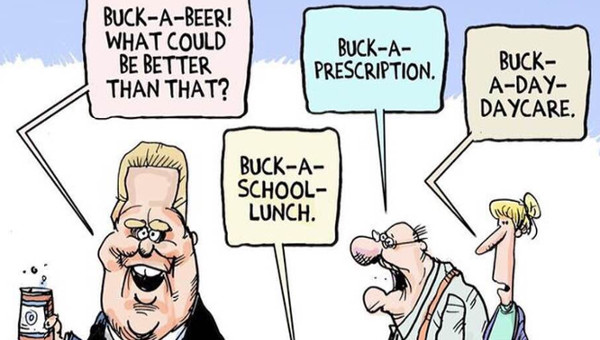“If the soul is left in darkness, sins will be committed. The guilty one is not he who commits the sin, but he who creates the darkness.”
— Monseigneur Bienvenu in Victor Hugo’s Les Miserables
It is always the same. First the shock and horror, then the anger. A terrible environmental disaster inflicted by Beyond Petroleum in the Gulf of Mexico; a horrendous explosion at Union Carbide’s Bhopal plant; a mine disaster, burying people at Westray in Nova Scotia; a factory building collapsing in Bangladesh; a train’s cargo exploding and incinerating people and the city of Lac-Mégantic.
 Each time there are the same questions:
Each time there are the same questions:
Why was anyone allowed to engage in this activity, given its known risks? Why, more specifically, were people with poor reputations in respect of safety and/or people with little experience allowed to run these risky activities? Why did governments not have better laws and regulations? Why did governments not have better monitoring and policing of such laws and regulations they had enacted? How dared the leaders of these risk-creating entities try to blame their hapless underlings? How could they be so cavalier, so callous, so arrogant? Who was to pay for the compensation? Should anyone go to jail?
The reasons for the shock and anger are obvious: the burned bodies, destroyed lives and livelihoods, ravaged environments, disrupted communities, misery all round. And each time, sombre-looking politicians and policy-makers walk around the sites, solemnly promise to learn from the event, assuring the stunned public that they will not let it happen again, that heads will roll if legal justice demands it.
Civilized Political Economy?
Each time people are shocked and horrified because they believe that they live under a regime of a mature and civilized political economy. They have been told that for-profit entrepreneurs care about their health and safety; they are taught that their elected governments will force entrepreneurs to put health and safety and environments ahead of profit-maximization. They want to believe all of this because their daily lives would be miserable if they thought that their food was unsafe, that most products they use are unchecked for dangers, that there are hundreds and thousands of untested toxic substances used in profit-making activities and released into their environments, that their physical recreational activities are largely unmonitored and unregulated, that their workplaces are high hazard zones. They are gulled into believing that everyone, profit-chasers and governments, cares about them because, at any one time, there is a high decibel vociferous debate, usually dominated by apparently respectable profit-seekers and their professional think-tanks, about how unnecessary government regulations impede the creation of wealth while, at the same time, they fail to protect society.
An impression is left that there is a great deal of supervision and monitoring. It looks to all the world that it is not the lack of regulation by governments, but its excesses, that impoverish and endanger us. Thus it is that, when a Lac-Mégantic occurs, everyone is surprised that it could happen at all: surely something has gone wrong with the otherwise satisfactory operations of profit-seekers and/or the well-established government oversight over profit-making?
But, the only thing that is special about a Lac-Mégantic is the sudden manner in which a huge amount of harm is inflicted. The infliction of harms is a daily event; but it is experienced as atomized, isolated events, unworthy of news coverage. We hardly notice the steady dripping of blood, the innumerable illnesses, serious and minor, daily deaths and incremental deterioration of our physical environments. We are systematically desensitized to the catastrophic dimensions of the injuries that regulated profit-seekers inflict. This is an amazing triumph for harm-inflicting profiteers. To illustrate:
While the trauma of a Westray, understandably and rightly, demands everyone’s attention, the 26 miners who died in one spectacular explosion are but a tiny fragment of the number of workers injured and killed every day. In Canada, roughly one thousand people are killed on the job each and every year, nearly 5 every working day; 10,000 die earlier than they might have because of occupationally related illnesses each and every year. World-wide, 2 million people die at work every single year; 260 million more are injured while at work. And, yearly, 160 million are afflicted by job-related illnesses. The number of deaths and illnesses attributable to environmental pollution and degradation are equally staggering; product contamination, unsafe vehicles, equipment, drugs and pharmaceuticals, all exact huge tolls.
Sadly, then, Lac-Mégantic is but an eye-catching example of a common phenomenon. It is but a vivid example of the routine operation of competitive capitalism, our supposedly well-regulated competitive form of capitalism. There should be no sense of surprise. Anger, yes, surprise, no. The key to this parlous state of affairs is the fact that our regulatory laws and standards are intended to legitimate a harm-causing, risk-shifting system. Regulatory law works on a set of assumptions:
- Productive activities create material welfare;
- All productive activities entail risks;
- Productive activities create the most material welfare if they are undertaken privately for selfish motives;
- Productive activities should be promoted and facilitated by governments and their agencies;
- Any materialized risks may harm the producers, the consumers and users of the goods and services produced and the general environment;
- Promoting and facilitating governments and their agencies should ensure, as much as possible, that the wealth generated by any productive activity outweighs the harms it inflicts. They are to engage in a cost-benefit analysis.
This framework assumes that private actors chasing profits are engaged in virtuous activities and that they are virtuous. All want to produce welfare; no one wants to do harm. Thus when risks materialize, we should compensate the victims and educate all concerned about that particular risk and, if necessary, enact laws and standards to ensure that appropriate precautions be taken to avert or diminish the materialization of this and similar risks. The enforcement of those standards may well require imposing sanctions on those producers who violate them but we should not think of them as anti-social wrongdoers. After all, we should be grateful that they are voluntarily engaging in the virtuous activity of contributing to the general welfare. Only in extremis should we think of them as moral lepers, as criminals.
The logic of this assumed state of play means that
- Its cost-benefit approach does not require that all risks be eliminated. A price has to be paid for the general good, a price to be paid by workers, consumers, users, communities and their natural environments.
- It legitimates a certain amount of acceptable harm, a certain amount of bleeding and illness, a certain number of deaths, a certain amount of environmental despoliation. We are told that, in our desire for welfare, we must, and are assumed to be, willing to sacrifice bodies, lives and our ecology. The assumptions of our regulatory theory embody the crass social Darwinism of John D. Rockefeller, who wrote:
“The American Beauty Rose can be produced in the splendor and fragrance which bring cheer to its beholder only by sacrificing the early buds which grow up around it. This is not an evil tendency in business. It is merely the working-out of a law of Nature and a law of God.”
The harms inflicted by the entrepreneurial class initiating productive activities are designed into them, either by not setting standards at all or by having some rules balancing benefit against what is deemed to be an acceptable level of harm.
This is why we are not shocked by the daily atomized materializations of risks built into the productive processes. We expect a certain kind and amount of damage. What we do not know in advance is who the victims will be or the full extent of the harm they will suffer. It is only when a Westray or a Lac-Mégantic occurs that we ask questions and they are all about whether there was anything peculiar about the circumstances: were there defensible rules balancing benefit against harm in place? were they satisfactorily monitored and enforced or were the governmental regulators too lax? was the particular entrepreneur not virtuous, a rotten apple in the barrel of goodness, who flouted perfectly acceptable rules?
Cost-Benefit Analyses
The questions about whether the existing regulations were satisfactory ones are not questions about the validity of the cost-benefit analysis that gives life to these kind of regulations, but rather about the difficulties that inhere in setting an appropriate and acceptable level of harm. And the questions about regulators arise because we realize they have an unenviable task.
The cost-benefit analyses required involves calibrating incommensurables. There is the cost of putting in a preventive system which theoretically can be calculated in dollars and cents, although the asymmetry of information means that, in practice, regulators have to rely on data provided by entrepreneurs who have an incentive to exaggerate the expense to put in, say, a new ventilation system, and to be less than forthcoming about exactly how much profits they have to earn to be willing to stay in business. On the other side of the equation, it is hard to measure the benefit bestowed by any one productive activity and even harder to measure the cost of the economic losses suffered by the victims of a materialized risk. This difficulty is compounded by our total inability to measure the pain, suffering or the emotional and psychic losses of such victims. The design of regulations is always going to be contested and their legitimacy easily contestable, making for great enforcement difficulties. These difficulties are compounded by the complexity and dimensions of the problems of drafting these kinds of regulations.
There are innumerable productive activities out there, all to be welcomed, to be sure, but they are so many and so varied, that regulators have to rely on information provided to them. There is no incentive for entrepreneurs, other than their assumed virtue, to establish that their particular enterprise presents risks and/or that they should spend money to avert them. Governments depend on their own instincts and, to some extent, on academic research (this is notoriously under-resourced) but, mostly, on the accumulated experience of harms suffered in the past. Hurt and killed workers, consumers, users, and visible environmental degradation are the main sources of information for regulators charged with balancing the supposed benefits of productive activities against the harms they inflict.
We get new safety standards when the harms inflicted by for-profit activities become too great, too politically embarrassing to accept. If one worker loses a hand in a machine, it is an accident; if ten workers lose a hand using the same machine, it is a cluster; if 100 lose their hand to this machine, we get a regulation requiring that a guard be put on the machine. This is the history of our Factory Acts and the regulations now attached to our contemporary omnibus health and safety legislation. And, it is the story of Lac-Mégantic. The media already carry stories as to how railways are saying that they will revise their own safety rules in expectation of a barrage of regulatory activity by governments that now have the bodies, destroyed property and polluted air and water of Lac-Mégantic piled on their doorsteps. The rail operators hope that the optics of sincere concern will minimize the extent and expense of the inevitable regulations to come. (Toronto Star, 19 and 20 July).
When the regulators have information about the potential for injuries to people, their property or the environment, they consult with the entrepreneurs whose initiatives create the potential harms but whose initiatives they do not want to inhibit. Thus, after the Lac-Mégantic disaster, we learned that federal rules already provided that trains left unattended must have sufficient handbrakes applied to prevent movement and that the operators of the trains must ensure that this has been done. But, in promulgating this standard, the government had entered into an agreement with the regulatees, the train operators, and the definition of what had to be done to comply with the requirement of ‘sufficiency’ is still kept secret. (Toronto Star, 19 July, 2013). This imposition of a public duty was privately arranged. Regulators rely on, and trust, the people they regulate. The cost-benefit analyses begin with the notion that virtuous actors must not be discouraged from engaging in virtuous activities. And the premise of the virtue of enterprise means that the field in which regulations will be crafted is seriously tilted in favour of allowing the benefit of production to be hyped and the risks and potential adverse impacts to be minimized. The starting point is that the materials used, the equipment deployed, the technologies employed, the mode of operation, are not to be questioned by outsiders, lest efficiency is impaired, unless there is clear evidence that the harms they might cause are likely to occur and, should they do so, be grave.
The starting point, then, is that entrepreneurs and their choices are entitled to the presumption of innocence.
Asbestos, lead, mercury, iso-cyenates, DDT, vinyl chloride, thalidomide, fracking, nuclear power plants, off-shore oil drilling, unsupervised cooltan mining by desperate people in Africa, peddling infant formula in poor countries without proper precautions, and so on, are all presumed innocent.
Unlike the racially different-looking people who are profiled, harassed, questioned when standing on bus stops, driving a car, walking in a fancy neighbourhood, and sometimes shot for being the wrong person in the wrong place;
Unlike Mohamed Harkat who was arrested pursuant to the National Security Act ten years ago on suspicion of being a sleeper agent. He was never convicted of such an offence and has, just now, been given mild relief from the restraints put on him. He was under house arrest for 7 years and had to wear a tracking bracelet at all times, a prisoner in his home. He now may have a mobile telephone, but must still allow the border police to get access to his record of communications kept by his server; he now may have a home computer, but it, too, is subject to monthly inspections. He may even travel outside the Ottawa area where he resides, but he must give the border agency his itinerary and five days’ notice;
Unlike the ‘militants’ killed by drones or any of the people on what the press call the ‘kill lists’ kept by the U.S. and NATO. None of those people are ever charged with an offence, let alone convicted of one;
Unlike all of us, as the Edward Snowden revelations told us. The dragnet nature of surveillance by NSA and PRISM is posited, not on the belief that those surveyed have done anything warranting action, but that they might do so. If we are not necessarily presumed to be guilty, we are certainly not assumed to be virtuous, unlike those who invest for profit and unlike the substances, equipment, technology and processes they use.
Entrepreneurs Are Capitalists
The assumptions about the virtuous nature of our private wealth generation regime and the attendant presumption of innocence mean that the regulatory balancing and bargaining takes place on a tilted field, tilted in favour of the so-called virtuous producers, guaranteeing that we will suffer more Westrays and Lac-Mégantics and thousands and thousands of unkind, hurtful, atomized cuts and harms. What is wrong with the assumed framework is that it assumes capitalism away.
This piece has persistently referred to capitalists as entrepreneurs wedded to profits because this is the characterization regulatory relies on to work its magic. It permits the treatment of profit-maximization to be portrayed as one undertaken for the public’s well-being. But, these benign-sounding entrepreneurs are capitalists and they do not care about the public’s welfare; only their own.
Capital and capitalists should not be seen as virtuous, as entitled to start with the presumption of innocence. Capitalists are out to maximize profits. They decide how much to invest, for what reason, for how long, where it is to be invested, what kind of equipment and resources and technologies will be used, how many workers and what kind of a labour force will be recruited, and so forth. This is called business planning. But, it is planning to enable them to become rich, it is planning that aims at the private accumulation of socially produced wealth. They are to do this by out-competing their rivals. Competition is the driver of the system. In recent times, this elemental force, competition, appears to have intensified, pushing capitalists to greater and greater extremes.
Capitalists need to, and want to, reduce the costs of production. They do this by forcing workers to compete with each other; unemployment is not such a bad thing; the increasing capacity to outsource work is a marvelous thing; they drive down wages and benefits by any means at hand, including the development of new technologies and innovative processes that allow them to displace human beings. They also reduce their costs to improve their profits, of course, by externalizing the costs of production, that is, by making others pay these costs. This includes the harms inflicted by the productive processes and the goods and services they produce. Injured and hurt workers and their dependents, consumers, users, and the environment in which we all live are to pay the price.
Inasmuch as regulations are imposed to protect workers and to internalize some of those production costs otherwise shifted to non-profit seekers, they are unwelcome. They are to be resisted. And capitalists do. They threaten to withhold their capital if regulators threaten them. They ask for ‘no or, at worst, reasonable’ regulation. It follows that a bargaining regime that lets these exploiters help set the limits on their exploitation is bound to fail. Capitalists will gild the lily when they tell the regulators about the risks and the precautions they are taking; they will prevaricate when they declare how high the costs of compliance will be; they will violate the standards set if this is likely to yield a profit, especially if they think they will not be caught and, if caught, not be punished very severely.
“The obvious fact that capitalism and capitalists do not care a whit about the public welfare, should put some doubt in regulators’ minds about the virtue of ‘entrepreneurs.’ Yet, it does not.”
Lying and cheating are built into a legal regulatory framework that pretends that it merely has to address the problems of productive activities engaged in by virtuous actors for virtuous reason. The frailty of this assumption is further demonstrated by the fact that regulatory theory ignores evidence all around us: in their drive to accumulate, capitalists will produce literally anything that sells, from food, to medicine, to tobacco, to alcohol, to guns, to body parts, to anything at all. The obvious fact that capitalism and capitalists do not care a whit about the public welfare, should put some doubt in regulators’ minds about the virtue of ‘entrepreneurs.’ Yet, it does not. The ugly drive to make everything saleable has no logical limits in capitalism, corroding our values and cultures. Capitalists are self-interested, uncaring, anti-social actors, not worthy of presumptions in their favour.
Capitalism and capitalists are not virtuous. The system is criminogenic.
So, while it is true that all productive activities entail risks, they are not the same risks for the same people or locales if the aim of production is not set by the competitive model to maximize profits by reducing costs. If people’s needs were the object of production, the safety of the workers doing the producing, that of the consumers and users of the goods and services produced, the maintenance of a healthy environment would be front and centre in what is now called business planning. More, it would make perfect sense to have all these people whose needs were most likely to affected, participate directly in the planning and in the decision-making about what risks to accept and about what needs they wanted to satisfy, rather than have them participate by bleeding and dying. Productive activities would still entail risks, but risks more democratically accepted and acceptable.
Until we make the points about the toxic and fraught nature of our regulatory framework and the radical changes this demands, the bleeding, the dying, the illnesses, the degraded environment will continue, and likely get worse.
Lac-Mégantic should make us angry. Let our anger be informed anger. Let us not go down the path of looking for reform to a regulatory system that is designed to fail us. •





